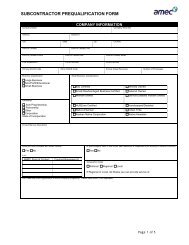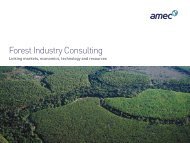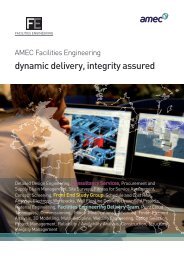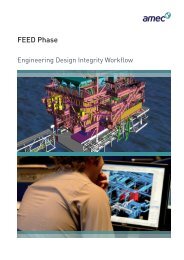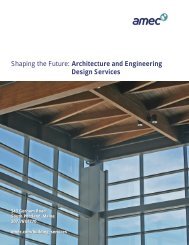Detailed Engineering Design Phase - Engineering Design ... - Amec
Detailed Engineering Design Phase - Engineering Design ... - Amec
Detailed Engineering Design Phase - Engineering Design ... - Amec
You also want an ePaper? Increase the reach of your titles
YUMPU automatically turns print PDFs into web optimized ePapers that Google loves.
<strong>Detailed</strong> <strong>Engineering</strong> <strong>Design</strong> <strong>Phase</strong><br />
<strong>Engineering</strong> <strong>Design</strong> Integrity Workfl ow
Introduction<br />
<strong>Detailed</strong> <strong>Design</strong> <strong>Engineering</strong> <strong>Design</strong><br />
Integrity Workfl ow (EDIW)<br />
EDIW is AMEC’s best practice guidance to <strong>Engineering</strong> Managers and supporting<br />
personnel for the delivery of technical integrity. It is an ‘aide-memoir’ that highlights<br />
the key deliverables and activities throughout the lifecycle of a typical <strong>Detailed</strong> <strong>Design</strong><br />
project.<br />
<strong>Detailed</strong> <strong>Design</strong> is broken into seven phases:<br />
1 Scope Defi nition and <strong>Engineering</strong> Execution Strategy<br />
2 Commencement of <strong>Detailed</strong> <strong>Design</strong><br />
3 Initial <strong>Design</strong> Development and Hazard Identifi cation<br />
4 Initial <strong>Design</strong> Review & Audit<br />
5 Approval for <strong>Design</strong> (AFD)<br />
6 Approval for Construction (AFC)<br />
7 <strong>Design</strong> Close-Out<br />
The workfl ow shown in the EDIW Road Map illustrates the execution sequence on a generic<br />
Detail <strong>Design</strong> Project. The vertical columns show activities that can be undertaken concurrently<br />
whilst the sequential fl ow of work is across the Road Map. As the deliverables and activities in each<br />
phase are completed, work can transition into the next phase.<br />
Situations will arise when work will need to be be done out of sequence, typically to meet a<br />
demanding project schedule. Use of the EDIW allows the risks of out-of-sequence working to be<br />
identifi ed and the necessary mitigation strategies to be put in place.<br />
AMEC’s corporate governance and assurance of <strong>Engineering</strong> will measure compliance with the<br />
EDIW workfl ow and ensure out-of-phase working is being identifi ed and managed. This document<br />
contains a copy of the Detail <strong>Design</strong> EDIW Workfl ow Road Map and includes detailed descriptions of<br />
the activities, the key engineering disciplines and supporting documentation.<br />
1
<strong>Phase</strong> 1<br />
Scope Defi nition and <strong>Engineering</strong> Execution Strategy<br />
Preparation for commencement of detail design. To evaluate FEED deliverables to ensure<br />
engineering is suffi ciently mature for detail design to progress in a controlled and minimal<br />
change environment. To confi rm <strong>Engineering</strong> Execution Plan.<br />
Activities / Deliverables Description<br />
1<br />
2<br />
3<br />
4<br />
5<br />
6<br />
<strong>Engineering</strong><br />
Execution Strategy<br />
Feed / BoD<br />
Validation<br />
Project Baseline<br />
Standards<br />
<strong>Engineering</strong> Audit<br />
Schedule<br />
<strong>Engineering</strong><br />
Execution Plan &<br />
<strong>Engineering</strong><br />
Organisation Chart<br />
Integrated<br />
<strong>Engineering</strong><br />
Systems<br />
7 QRA & FRA Strategy<br />
8<br />
9<br />
10<br />
11<br />
Discipline Job<br />
<strong>Design</strong> Specifi cation<br />
Level 3<br />
<strong>Engineering</strong> Plan<br />
Confi rm CE<br />
Compliance Strategy<br />
Technical Risk<br />
Register<br />
Review / confi rm <strong>Engineering</strong> Execution Strategy, e.g.<br />
execution locations, workshare, disciplines required,<br />
specialist support, etc.<br />
Confi rm maturity of Front End <strong>Engineering</strong> <strong>Design</strong>. Identify<br />
any areas of concern and ensure these are captured on the<br />
Technical Risk Register.<br />
Establish which codes, standards and specifi cations are to be<br />
utilised, eg. Corporate, project, client, and confi rm procedure.<br />
Include in <strong>Engineering</strong> Execution Plan and / or Discipline Job<br />
<strong>Design</strong> Specifi cations.<br />
Create formal schedule to identify when technical integrity<br />
audits, design reviews, HAZIDS, HAZOPS, etc are to be carried<br />
out. Align to Level 3 <strong>Engineering</strong> Plan and include in<br />
<strong>Engineering</strong> Execution Plan.<br />
Create <strong>Engineering</strong> Execution Plan complete with key<br />
supporting documents / information.<br />
Agree engineering design tools to be used and confi rm<br />
that system hardware, software and support is available.<br />
Include issues such as PDMS or PDS, Cats and Specs, survey<br />
methods, dimensional control techniques, etc. Document and<br />
record in the <strong>Engineering</strong> Execution Plan and discipline job<br />
design specifi cations.<br />
Establish status of project Quantitative Risk Assessment<br />
(QRA), Fire Risk Assessment (FRA) and Emergency Escape &<br />
Rescue Assessment (EERA) information and confi rm<br />
methadology for timely delivery into engineering design<br />
process. Agree accountability for delivery, eg. Client, 3rd<br />
party, AMEC, and record in <strong>Engineering</strong> Execution Plan.<br />
Defi ne the key project specifi c design parameters and<br />
operational constraints that are applicable to the appropriate<br />
discipline for the detailed design of the project. To identify key<br />
individuals, roles and responsibilities, design tools, key codes<br />
and standards, etc.<br />
Agree work breakdown structure, develop CTRs and create<br />
level 3 integrated engineering plan covering all disciplines. To<br />
be included in <strong>Engineering</strong> Execution Plan.<br />
Review and confi rm strategy for CE Compliance . Ensure<br />
discipline Lead Engineers are aware of their responsibilities<br />
and appropriate resources / measures are in place.<br />
Create formal Technical Risk Register identifying all possible<br />
risks asscociated with the engineering design.<br />
Key<br />
Discipline<br />
Project<br />
Manager<br />
and Project<br />
<strong>Engineering</strong><br />
Manager<br />
Project<br />
<strong>Engineering</strong><br />
Manager<br />
Project<br />
<strong>Engineering</strong><br />
Manager<br />
Project<br />
<strong>Engineering</strong><br />
Manager<br />
Project<br />
<strong>Engineering</strong><br />
Manager<br />
<strong>Engineering</strong><br />
Systems<br />
and All<br />
Disciplines<br />
Technical<br />
Safety<br />
All Disciplines<br />
All Disciplines<br />
Project<br />
<strong>Engineering</strong><br />
Manager<br />
Techncal Safety<br />
Supporting Documentation<br />
Tender documentation, Project Execution Plan<br />
(PEP)<br />
<strong>Engineering</strong> Baseline Standards, Document No.<br />
OAG-X160-190-GDL-012 (previously<br />
AOD-92-043 )<br />
Technical Safety Events Schedule<br />
(Lead Technical Safety Engineer)<br />
<strong>Engineering</strong> Systems Project Start-up Manual,<br />
Document No. OAGX160-170-MAN-002<br />
Hazard Management Philosophy, OAG-X160-<br />
190-GDL-009 (previously AOD-97-001):<br />
Hazard & Risk Management, OAG-X160-190-<br />
PRO-024<br />
Corporate CE Compliance Strategy OAG-<br />
X160-190-MAN-001; Project Compliance with<br />
Pressure Equipment Regulations OAG-X160-<br />
050-PRO-001; Pressure Equipment<br />
Regulations Guidelines AOD-97-047; ATEX<br />
Guidelines, OAG-X160-190-GDL-003; Machinery<br />
Directive Guidelines, O&G-ENG-REP-29-001;<br />
Electromatic Compatibility Regulations<br />
Guidelines, OAG-X160-190-GDL-003; MC, The<br />
Electrical Equipment (Safety) Regulations<br />
Guideleines, OAG-X160-190-GDL-003.<br />
2
<strong>Phase</strong> 2<br />
Commencement of Detail <strong>Design</strong><br />
To formally kick off the <strong>Engineering</strong> <strong>Design</strong> Process in accordance with the project execution plan<br />
and to ensure that key engineering strategies / philosophies are in place.<br />
Activities / Deliverables Description<br />
1<br />
2<br />
3<br />
4<br />
5<br />
3<br />
Performance<br />
Standards &<br />
Verifi cation Scheme<br />
Document<br />
Distribution Matrix<br />
Structural Integrity<br />
Interface<br />
Material Selection<br />
Report<br />
Hazard Management<br />
Plan<br />
6 Piping Specifi cations<br />
7 PDMS Calalogues<br />
8 CMSS Philosophy<br />
Confi rm safety critical systems / elements and set<br />
appropriate performance standards. i.e. functionality,<br />
reliability and survivability. Develop scheme to allow the<br />
independent competent body (ICB) to verify the design<br />
against the performance standards.<br />
Create formal document distribution matrix to ensure all<br />
disciplines & departments receive all necessary design<br />
information in a timely manner.<br />
Ensure structural integrity interfaces are identifi ed & visible<br />
to Project, e.g. AMEC / Client focal points, Technical<br />
Authorities, Independent Verifi cation Bodies, etc.<br />
Report defi ning the requirements and specifi cations of<br />
necessary material.<br />
Create Hazard Management Plan identifying all key hazards,<br />
technical safety activities and the approach to managing<br />
Major Accident Hazards (MAH) in the design.<br />
Develop / confi rm baseline piping specifi cations, utilising<br />
AMEC Corporate specifi cations where possible.<br />
Ensure PDMS catalogues are populated & available for all<br />
affected disciplines, utilising AMEC Corporate data, i.e. CPC,<br />
where possible.<br />
Develop Control Monitoring and Safety Systems (CMSS)<br />
Philosophy covering key instrumentation and control systems<br />
e.g. Process Control System (PCS), Emergency Shutdown<br />
System (ESD) and Fire and Gas (F&G).<br />
Key<br />
Discipline<br />
Technical<br />
Safety<br />
Project<br />
<strong>Engineering</strong><br />
Manager<br />
Structural<br />
Metallurgy<br />
Technical<br />
Safety<br />
Supporting Documentation<br />
Hazard Management Philosophy, OAG-X160-<br />
190-GDL-009 (previously AOD-97-001); Hazard<br />
& Risk Management, OAG-X160-190-PRO-024;<br />
<strong>Design</strong> Verifi cation Activities (under DCR),<br />
OAG-X160-190-PRO-028; Platform Safety Case.<br />
AMEC Corporate Material <strong>Engineering</strong><br />
Specifi cations.<br />
Hazard & Risk Management, OAG-X160-190-<br />
PRO-024; Management of Functional Safety<br />
Guideline OAG-X160-190-GDL-004<br />
Piping AMEC Corporate Piping Specifi cations.<br />
<strong>Engineering</strong><br />
Systems,<br />
supported by<br />
Piping,<br />
Electrical,<br />
Instruments,<br />
Structural &<br />
HVAC<br />
Instruments
<strong>Phase</strong> 3<br />
Initial <strong>Design</strong> Development and Hazard Identifi cation<br />
To develop initial design deliverables to Inter Discipline Review (IDC) stage and identify key hazards.<br />
Activities / Deliverables Description<br />
1 HAZID<br />
2 ENVID<br />
3 PFD IDC<br />
4<br />
Shutdown & Blowdown<br />
Philosophy<br />
5 P&ID’s IDC<br />
6 C&E IDC<br />
7 Plot Plans / Layouts IDC<br />
8<br />
Hazardous Area<br />
Layouts IDC<br />
9 Equipment List<br />
10<br />
11<br />
12<br />
13<br />
Mechanical Handling<br />
Strategy<br />
Particular Material<br />
Appraisals (PMA)<br />
Fire Risk Assessment<br />
(FRA)<br />
Emergency Escape &<br />
Resecue Assesment<br />
(EERA)<br />
14 Dropped Object Study<br />
15 Blast <strong>Design</strong> Philosophy<br />
16 PFP / AFP Philosophy<br />
17 HIPPS Review<br />
Perform hazard identifi cation studies, as identifi ed on<br />
<strong>Engineering</strong> Audit Schedule / Technical Safety Events<br />
Schedule.<br />
Formal assessment of environmental aspects associated<br />
with a modifi cation or a change, and to propose<br />
prevention or mitigating measures.<br />
Issue Process Flow Diagrams (PFD’s) on formal<br />
Inter-Discipline Review (IDC).<br />
Explain the measures to prevent and control blowdown<br />
and how this will be achieved.<br />
Issue Piping & Instrumentation Diagrams (P&ID’s) on<br />
formal Inter-Discipline Review (IDC).<br />
Issue Cause & Effects for formal Inter-Discipline<br />
Review (IDC).<br />
Issue equipment Plot Plans / Layouts on formal<br />
inter-Discipline Review (IDC).<br />
Issue Hazardous Area Layouts for formal<br />
Inter-Discipline Review (IDC).<br />
Create master project equipment list identifying all<br />
major items of tagged equipment, e.g. vessels, pumps,<br />
motors, generators, hydrocycolnes, chemical injection<br />
packages, electrical switchgear, control panels, etc.<br />
Develop Mechanical Handling Strategy including general<br />
approach / constraints, platform crane limits, installation<br />
philosophy, operation and maintenance, etc.<br />
Where required, i.e. where Corporate PMA’s or EAM’s<br />
are not suitable, develop new PMA’s and obtain approval<br />
from Notifi ed Bodies (NoBo’s).<br />
Determine Fire & Explosion scenarios and identifi es<br />
requirements for prevention, control and mitigation<br />
measures.<br />
Identify requirements for emergency escape & rescue,<br />
e.g. lifeboats, escape routes, plant layout, etc<br />
Identify and assess the potential risks to drilling,<br />
production, process equipment, and manned areas from<br />
dropped or swinging objects. Where the consequence<br />
of a dropped object is considered signifi cant, to propose<br />
prevention or mitigating measures.<br />
Develop philosophy that assesses potential explosion<br />
hazards and identifi es appropriate blast loadings to be<br />
applied to the engineering design process, eg. Vessels,<br />
pipe supports, structural steel, etc.<br />
Develop philosophy that identifi es requirements for<br />
Passive Fire Protection (PFP) and/or Active Fire<br />
Protection (AFP).<br />
Initial review to establish requirements for a High<br />
Integrity Pressure Protection System.<br />
Key<br />
Discipline<br />
Technical<br />
Safety<br />
Technical<br />
Safety<br />
Process<br />
Process<br />
Process<br />
Process and<br />
Instruments<br />
Piping and<br />
Layouts<br />
Technical<br />
Safety<br />
Mechanical<br />
Mechanical<br />
and Structural<br />
PED Focal<br />
Point<br />
Technical<br />
Safety<br />
Technical<br />
Safety<br />
Technical<br />
Safety<br />
Technical<br />
Safety<br />
Technical<br />
Safety<br />
Instruments<br />
Supporting Documentation<br />
Project Hazard Identifi cation (HAZID) AOD-92-<br />
018; <strong>Engineering</strong> & <strong>Design</strong> Reviews, OAG-X160-<br />
190-PRO-013.<br />
Environmental Impact Identifi cation (ENVID)<br />
OAG-X160-190-PRO-121; <strong>Engineering</strong> & <strong>Design</strong><br />
Reviews, OAG-X160-190-PRO-013.<br />
Management of Functional Safety,<br />
OAG-X160-190-GDL-004<br />
4
<strong>Phase</strong> 4<br />
Initial <strong>Design</strong> Review and Audit<br />
To confi rm that the initial design development is robust.<br />
5<br />
Activities / Deliverables Description<br />
1 Hazardous Area Review<br />
2<br />
3<br />
P&ID Review and / or<br />
‘Initial Hazop’<br />
Plot Plans / Layout / 3-D<br />
Model Review<br />
4 C&E Review<br />
5 Technical Audit<br />
Formal <strong>Engineering</strong> discipline review of hazardous area<br />
layouts to confi rm requirements for the correct selection<br />
and location of equipment.<br />
Formal <strong>Engineering</strong> discipline review of P&ID's to<br />
confi rm design basis.<br />
Formal <strong>Engineering</strong> review of Plot Plans / Layouts. The<br />
review shall ensure that the layout design complies with<br />
the required technical, safety, operability and<br />
maintainability standards. Makes sure the layout is cost<br />
effective, ensures the constructability of the work and<br />
agrees the layout basis on which the detailed design can<br />
proceed.<br />
Formal review of Cause & Effects diagrams to confi rm<br />
design basis and alignment with Hazard Management<br />
Plan.<br />
Obtain confi rmation, by sampling of project<br />
documentation, that the engineering of the project is to<br />
the required standard and free from errors.<br />
Key<br />
Discipline<br />
Technical<br />
Safety<br />
Process,<br />
Piping,<br />
Technical<br />
Safety,<br />
Instruments<br />
Piping and<br />
Layouts,<br />
Structural,<br />
Mechanical,<br />
Electrical,<br />
Technical<br />
Safety, Process<br />
Instruments,<br />
Process,<br />
Technical<br />
Safety<br />
Independent<br />
(Corporate<br />
<strong>Engineering</strong>)<br />
Supporting Documentation<br />
Hazard and Risk Management Procedure<br />
OAG-X160-190-PRO-024; <strong>Engineering</strong> &<br />
<strong>Design</strong> reviews, OAG-X160-190-PRO-013<br />
Formal Hazop, OAG-X160-190-PRO-017;<br />
<strong>Engineering</strong> & <strong>Design</strong> Reviews, OAG-X160-190-<br />
PRO-013<br />
<strong>Engineering</strong> & <strong>Design</strong> Reviews,<br />
OAG-X160-190-PRO-013<br />
Hazard and Risk Management Procedure<br />
OAG-X160-190-PRO-024; <strong>Engineering</strong> &<br />
<strong>Design</strong> reviews, OAG-X160-190-PRO-013;<br />
Management of Functional Safety Guideline<br />
OAG-X160-190-GDL-004<br />
Technical Audit Procedure<br />
OAG-X160-190-PRO-022
<strong>Phase</strong> 5<br />
<strong>Design</strong> Approval<br />
To ‘Freeze’ the Process design, and develop dependent design & procurement activities.<br />
Activities / Deliverables Description<br />
1<br />
PUWER<br />
Assessments<br />
2 HAZOP<br />
3 SHE Audit (AFD)<br />
4<br />
5<br />
Environmental<br />
Report<br />
Constructability<br />
Review<br />
6 P&ID AFD<br />
Conduct initial PUWER assessment typically by review of<br />
PDMS model and/or vendor / equipment supplier information<br />
received to date.<br />
Hazard and Operability Studies, a systematic multi-discipline<br />
study based on the applications of guidewords to identify<br />
causes of potential hazards and operability constraints in a<br />
facility.<br />
SHE Audit ensures that the design obligations under The<br />
Health and Safety At Work Act 1974 and project health, safety<br />
and environmental performance standards are being or have<br />
been met during the engineering and design processes.<br />
Issue fi nal report to document & confi rm that the design has<br />
considered all applicable environmental aspects &<br />
demonstrates that design controls have been included to<br />
minimise / control the environmental impact.<br />
Conduct formal Constructability Reviews to ensure safe and<br />
effi cient installation of plant & equipment.<br />
Issue Approved For <strong>Design</strong> (AFD) Process and<br />
Instrumentation Diagrams.<br />
Key<br />
Discipline<br />
Technical<br />
Safety,<br />
Mechanical<br />
Process,<br />
Technical<br />
Safety<br />
Technical<br />
Safety<br />
Technical<br />
Safety<br />
Affected<br />
disciplines +<br />
Construction /<br />
Implementation<br />
Group<br />
Process<br />
7 C&E AFD Issue Approved For <strong>Design</strong> (AFD) Cause & Effects. Instruments<br />
8<br />
9<br />
Process Data Sheets<br />
AFD<br />
HP / LP Interface<br />
Listing<br />
Issue Approved For <strong>Design</strong> (AFD) Process Data Sheets. Process<br />
Identify all HP / LP interfaces on formal register and ensure<br />
that all have been addressed satisfactorily via HAZOP’s and /<br />
or individual reviews.<br />
10 Holds Register Develop register to record & manage post AFD design holds.<br />
11 SIL Assessments<br />
12 HIPPS Study<br />
13<br />
14<br />
HIPPS Reliability<br />
Study<br />
SIL Achievement<br />
Report<br />
15 Flow Assurance<br />
16<br />
17<br />
Verifi cation of<br />
Vendor Information<br />
& Certifi cation -<br />
<strong>Design</strong> Completion<br />
PFEER<br />
Compliance Report<br />
Conduct assessment to determine target Safety Integrity<br />
Level (SIL). Note: Where the target SIL is 3, then it is likely<br />
that a High Integrity Pressure Protection System (HIPPS) will<br />
be required. If the value is found to be 1 or 2, then a HIPPS<br />
will not be required.<br />
Conduct study to formally identify the performance<br />
requirements of the High Integrity Pressure Protection<br />
System (HIPPS) and demonstrate that it is robust. Should<br />
include dynamic study for a range of transient conditions.<br />
Conduct study to formally demonstrate that the High Integrity<br />
Pressure Protection System (HIPPS) complies with the<br />
reliability & availability criteria for the Project, e.g. as<br />
stipulated in the performance standards.<br />
Conduct independent assessment to formally record that the<br />
target Safety Integrity Levels (SIL’s have been achieved) Must<br />
be completed prior to introduction of Hydrocarbons.<br />
Conduct fl ow assurance studies to demonstrate the process<br />
design under a range of fl ow conditions, i.e. start-up to 100%.<br />
Verify, primarily through review of vendor documentation,<br />
that their design & manufacture of fabricated packages, etc is<br />
robust and contains suffi cient information to facilitate<br />
completion of affected AMEC discipline design.<br />
Issue fi nal report as documented confi rmation that the design<br />
meets the requirements of the Prevention of Fire and<br />
Explosion, and Emergency Response (PFEER) Regulations<br />
Process<br />
<strong>Engineering</strong><br />
Manager<br />
Instruments<br />
Process<br />
Instruments<br />
Independent<br />
Competent<br />
Person (ICP)<br />
Process<br />
Affected<br />
disciplines<br />
Technical<br />
Safety<br />
Supporting Documentation<br />
<strong>Engineering</strong> & <strong>Design</strong> Reviews,<br />
OAG-X160-190-PRO-013<br />
Dependent on Project updated P&ID’s and<br />
C&E’s may be prepared from commented IDC’s<br />
from <strong>Phase</strong> 3 Formal HAZOP, OAG-X160-190-<br />
PRO-017 (previously AOD-92-022); <strong>Engineering</strong><br />
& <strong>Design</strong> Reviews, OAG-X160-190-PRO-013<br />
- Note: additional HAZOP’s may be required,<br />
i.e. earlier or later in the project. PEM to<br />
consult with Process & Technical Safety Lead<br />
Engineers.<br />
SHE Audit Procedure OAG-X160-190-PRO-023;<br />
<strong>Engineering</strong> & <strong>Design</strong> Reviews, OAG-X160-190-<br />
PRO-013<br />
<strong>Engineering</strong> & <strong>Design</strong> Reviews, OAG-X160-190-<br />
PRO-013<br />
<strong>Engineering</strong> & <strong>Design</strong> Reviews,<br />
OAG-X160-190-PRO-014<br />
Management of Functional Safety,<br />
OAG-X160-190-GDL-004<br />
Management of Functional Safety,<br />
OAG-X160-190-GDL-005<br />
Management of Functional Safety,<br />
OAG-X160-190-GDL-004<br />
Management of Functional Safety, OAG-X160-<br />
190-GDL-004<br />
6
<strong>Phase</strong> 6<br />
Approval for Construction (AFC)<br />
To ensure that suffi cient design information & certifi cation is available to facilitate<br />
safe installation, operation & maintenance.<br />
Activities / Deliverables Description<br />
1 SHE Audit AFC<br />
2<br />
IEC 61511<br />
Compliance Report<br />
3 PFD’s AFC<br />
4<br />
Operational Safety<br />
Case Development<br />
5 P&ID’s AFC<br />
6<br />
Quantative Risk<br />
Assessment (QRA)<br />
AMEC (LSE: AMEC) is a focused supplier of high-value consultancy, engineering and project management services to the world’s natural resources, nuclear, clean energy, water and environmental<br />
sectors. With annual revenues of over £2.5 billion, AMEC designs, delivers and maintains strategic and complex assets for its customers. The company employs some 22,000 people in around<br />
40 countries worldwide.<br />
For further information please see amec.com<br />
Conduct SHE Audit at AFC stage in accordance with<br />
Harmonised Procedure.<br />
Final report to formally demostrate that the Safety<br />
Instrumented Systems comply with the requirements of<br />
IEC 61511.<br />
Issue Approved For Construction (AFC) Process Flow<br />
Diagrams.<br />
Commence operational Safety Case development.<br />
Issue Approved For Construction (AFC) Process and<br />
Instrumentation Diagrams.<br />
Complete QRA activities to confi rm that the design is robust<br />
and complies with legislative requirements.<br />
Key<br />
Discipline<br />
Technical<br />
Safety<br />
Instruments<br />
Process<br />
Technical<br />
Safety<br />
Process<br />
Technical<br />
Safety<br />
7 C&E AFC Issue Approved For Construction (AFC) Cause & Effects. Instruments<br />
8<br />
9<br />
10<br />
11<br />
12<br />
Operating<br />
Procedures Review<br />
/ Operational HAZOP<br />
Fabrication<br />
Drawings AFC<br />
Verifi cation of<br />
Vendor Information<br />
& Certifi cation -<br />
Installation,<br />
Operation &<br />
Maintenance<br />
EC <strong>Design</strong><br />
Examination<br />
Certifi cates<br />
Declaration of<br />
Conformity<br />
<strong>Phase</strong> 7<br />
<strong>Design</strong> Close-Out<br />
Ensure operating procedures are verifi ed line by line against<br />
the facilities provided on the P&ID’s.<br />
Issue Approved For Construction (AFC) Piping Isometrics,<br />
Structural Steelwork drgs, etc.<br />
Verify, primarily through review of vendor documentation,<br />
that their design & manufacture of fabricated packages, etc is<br />
robust and contains suffi cient information to facilitate safe<br />
installation, operation & maintenance.<br />
Where AMEC are deemed to be the manufacturer of the piping<br />
systems, then under the PED/PER, AMEC have to apply to the<br />
Notifi ed Body (NoBo) for an EC <strong>Design</strong> Examination<br />
Certifi cate (Cat IV assemblies only).<br />
Where AMEC are deemed to be the manufacturer of the piping<br />
systems, then under the PED/PER, AMEC have to create a<br />
Declaration of Conformity, signed by the Project Manager.<br />
Activities / Deliverables Description<br />
1<br />
2<br />
3<br />
Safety Case<br />
Acceptance (HSE)<br />
Certifying Authority<br />
(CA) / Independent<br />
Verifi cation Bodies<br />
(IVB) Acceptance<br />
Complete<br />
Project As-Built<br />
Documentation<br />
Submit Safety Case to HSE & close out all queries /<br />
correspondance prior to next stage of operations.<br />
Close out all outstanding technical queries and obtain fi nal<br />
Letter of Acceptance.<br />
Complete as-builts of design drawings and deliverables in<br />
accordance with Project / Client requirements.<br />
Process,<br />
Technical<br />
Safety<br />
Affected<br />
Disciplines<br />
Affected<br />
Disciplines<br />
PER Focal<br />
point<br />
Project<br />
Manager<br />
Key<br />
Discipline<br />
Technical<br />
Safety<br />
Technical<br />
Safety<br />
Affected<br />
Disciplines<br />
Supporting Documentation<br />
SHE Audit Procedure OAG-X160-190-PRO-023<br />
Management of Functional Safety, OAG-X160-<br />
190-GDL-004<br />
Formal HAZOP, OAG-X160-190-PRO-017<br />
(previously AOD-92-022); <strong>Engineering</strong> & <strong>Design</strong><br />
Reviews, OAG-X160-190-PRO-013<br />
Project Compliance with the Pressure<br />
Equipment Directive, Document<br />
No. OAG-X160-190-GDL-007.<br />
Project Compliance with the Pressure<br />
Equipment Directive, Document<br />
No. OAG-X160-190-GDL-007.<br />
To ensure all fi nal design deliverables are completed and that client and statutory obligations are<br />
satisfactorily resolved.<br />
Supporting Documentation<br />
As Built Drawings and Documentation,<br />
AOD-92-021




